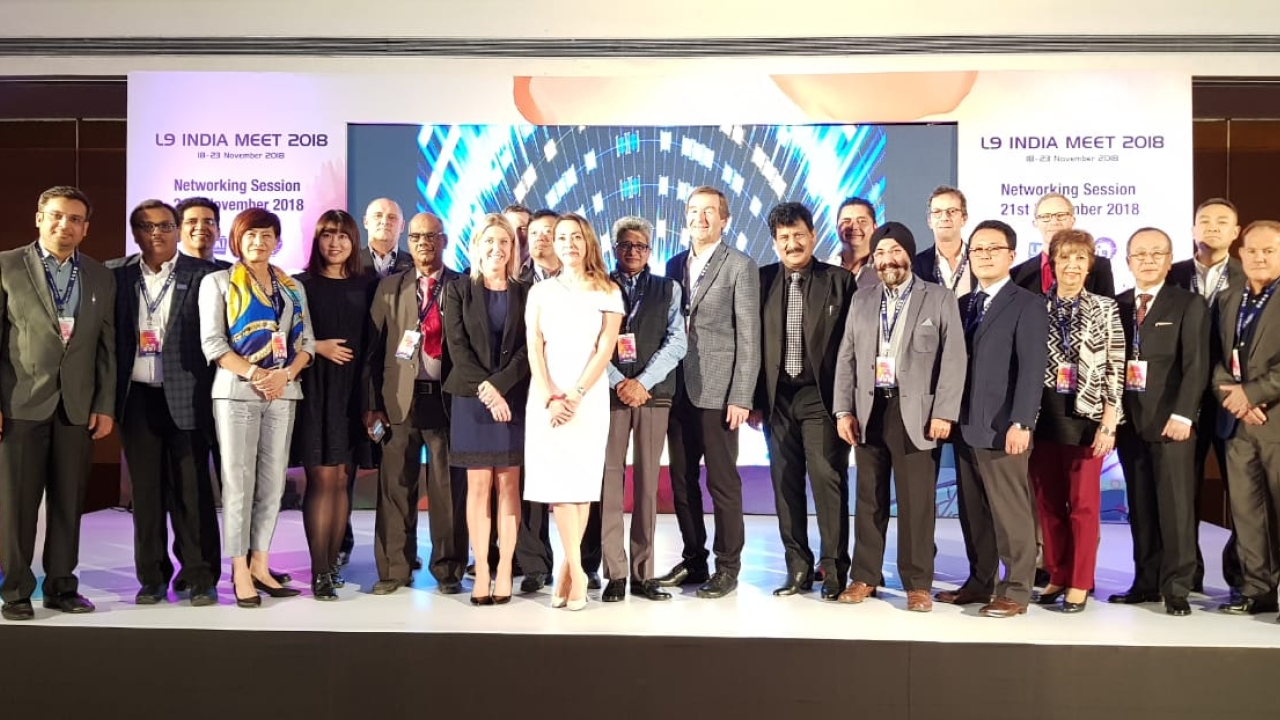India hosts L9 meeting
In the lead-up to Labelexpo India 2018, Label Manufacturers’ Association of India (LMAI) hosted the L9 meeting attended by label associations from across the world, including Finat, Ametiq, JFLP, PEIAC, Salma and TLMI.

The heads of the various associations spent three days together, hosting discussion meetings, conference presentations and networking events.
Sandeep Zaveri, past president of LMAI, welcomed L9 association presidents to the meeting, followed by an address by Thomas Hagmaier, L9 president. ‘This is the third L9 meeting that we have hosted after Japan and China. At L9, we learn from each other and look into the future,’ Hagmaier said.
Lisa Milburn, managing director of Labelexpo, highlighted trends in the Indian label industry. ‘The middle-class population in India is surging and the NCAER (National Council of Applied Economic Research) predicts that it will reach 547 million individuals by 2025, so there is huge growth in consumerism. With higher-specification presses coming in and an increase in sales of inspection equipment, it is clear that brand owners are demanding high print quality,’ she said.
Europe
Chris Ellison, Finat president, discussed trends and developments in the European label and short-run packaging market. ‘The top five markets in Europe are Germany, UK, Italy, France and Spain,’ he said. ‘The average per capita label consumption in Europe stands at 9.7sqm, with Denmark at 17.5sqm. The annual self-adhesive material demand in Europe is expected to soon exceed 7.5bn sqm. However, the label industry saw growth of 4.7 percent in 2017 which was below an average of 5.4 percent in the previous four years.’
Ellison highlighted recruiting and retaining talented employees as one of the top three challenges in the market, for which the association has launched the Labelicious program to attract fresh talent. The association represents 550 companies from Europe and beyond.
Latin America
Keren Becerra of Mexican association Ametiq gave an overview of the Latin American market. ‘Different segments dominate label printing in each region,’ she explained. ‘Chile, for example, is largely dedicated to the wine label industry, while Ecuador and Central America are more focused on fruit labeling. In Mexico, the fastest-growing areas for the label industry are Guadalajara, Monterrey and Mexico City.’
Becerra added that in Mexico, food labels and durable labels are seeing high growth. There is also an increase in shrink sleeve label use. However, she reported that there was an increase of 7 to 10 percent in the price of self-adhesive materials in the second quarter of 2018.
Japan
Yu Tanaka, chairman of Japanese association JFLP, discussed trends in Japan and best practices followed by the label industry. ‘The association has 550 members but the size of the market for the typical converter who has conventional printing presses is narrowing,’ he said.
India
Kuldip Goel, president of LMAI, said the association is committed to working towards the growth of Indian label industry and to keep it connected with the world. He further briefed about the activities conducted by LMAI in the last two years.
This was followed by a presentation by Ajay Mehta, managing director of SMI Coated Products, who highlighted common challenges discussed by L9 members during the India meeting. ‘Price pressures, finding skilled and talented workforce, and succession are three challenges our industry faces across the world. The Indian label market is different from that of Europe, because we see an overall growth trend in our country,’ he said.
‘Having said that, the market size in Europe is 7.5bn sqm and has grown by 1.5bn sqm in the past 10 years. The Indian label industry is only 400m sqm, so we have a long way to go. There is a surge in the middle class which presents an opportunity. However, the income of a middle class family is £4,000 GBP per year. Therefore, it will take a long time to reach double digit per capita consumption from the current 0.3sqm.’
China
Carrie Duan from PEIAC shared development and trends from China label printing industry. ‘The total output value of the China printing industry has reached US$17.6bn, with annual growth rate of 4.6 percent. Label printing represented US$6.8bn in 2017, which is an increase of 10 percent compared to the previous year. The total label production volume of 2017 stood at 5.8bn sqm which is an increase of 12 percent.’
There are 6,032 label converters in China, she said, and more new companies are being formed. ‘While wet-glue label consumption is 50 percent there is a lot of growth in pressure-sensitive labels, which represent 40 percent of the label market. Shrink sleeves and in-mold labelling are growing too. Duan said that food and beverage accounts for 30 percent of label consumption, followed by pharmaceutical at 20 percent. Cosmetics use 11 percent of labels, and the electronics and durables market stands at 8 percent and is growing fast.
China’s label printing industry continues to be primarily dominated by letterpress, comprising 39 percent of presses installed in the country. ‘Due to the fast development of flexo technology and stricter environment regulations, flexo printing presses comprise 34 percent of the market. The digital market is growing fast too,’ she said.
There is rapid development in e-commerce in China, which brings tremendous demand for labels and packaging in transport and logistics. ‘In 2017, e-commerce transactions were reported at 30 trillion RMB which was an increase of 11.7 percent from 2016. Online retail value is 7.18 trillion RMB, seeing a growth of 32.2 percent. There were 40 billion express deliveries made in 2017 compared to just one billion in 2010. There is also fast growth and development in RFID labels, whose market value is expected to reach US$4.3bn by 2025. There is rapid development of “3C products” (computer, communication and consumer electronics) which brings more opportunities,’ informed Duan.
She concluded by pointing out that China exported more than 400 label machines – presses, rewinders etc – worldwide in 2017, the value of which reached US$80m.
New Zealand
Mark Jackson of Salma, the New Zealand association, also highlighted growth in RFID market. He said: ‘Label growth is in sync with export growth and most converters target niche markets such as horticulture, dairy, beverage, FMCG and promotional. Wine and dairy are the largest markets for our label converters.’
North America
Michael Ritter of TLMI spoke of its annual financial benchmarking services. ‘Going forward the association will get more active with government regulations and in educating its members on how they could grow their businesses or raise their voice if they are against the legislation. We are also beginning to focus more on impact that our products have on the environment.’
The L9 India meet was concluded with a vote of thanks from Dinesh Mahajan, secretary of LMAI, which was followed by a networking evening sponsored by SMI Coated Products.
Knowledge sharing
Jules Lejeune, managing director of Finat, said the annual L9 meetings aim to facilitate knowledge sharing and best practices between the different association members. ‘The level of professionalism is rising since these events began in 2009. Communication is getting better. Each association has its own strengths which the others can learn from. There is great desire to increase our collaboration, and we are drawing up a series of proposals about how we can do that.
‘The LMAI has done a fantastic job in organizing the meeting this year.’
Stay up to date
Subscribe to the free Label News newsletter and receive the latest content every week. We'll never share your email address.

